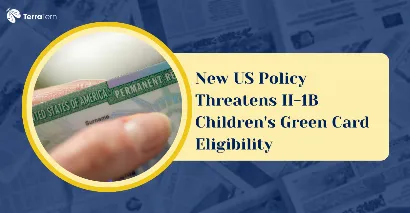Key Highlights
Indeed, the CSPA is a new rule that has sent shivers down the immigrant population, as the U.S. Citizenship and Immigration Services (USCIS) has proposed a major policy change that has shocked the world. This amendment, which will come into effect on August 15, 2025, changes the process by which the age of children seeking a green card based on the employment-based petitioning process of his or her parents is computed, including green card petitions through the H-1B visa. The action has left thousands of families, especially Indians, worried that their children will grow up and lose the opportunity to get a permanent residency status. The heart of the matter is the technical alteration of age calculations, which has humanistic implications beyond imagining; it can tear families apart and alter the lives of young adults who have been raised in the United States.
Also Read: US Visitor Visa B1/B2
The Heart of the Matter: A Change in Age Calculation
The update of the USCIS policy manual focuses on which of the dates listed by the Department of State in the Visa Bulletin is to be applied regarding the age of the child under the CSPA. USCIS continued to apply the more flexible Dates for Filing chart through many years, and since February 2023, the policy by the Biden administration. This was meant to safeguard children against ageing out, owing to backlogs in processing that in many cases take decades. The child could be frozen at a lower age by applying the previous date for filing, and thus, they could continue qualifying for a green card after having reached 21 years before the visa was finally granted.
The Switch to the "Final Action Dates" Chart
Under the new policy, the USCIS is no longer permitted to use the one-year rule to compute the CSPA age of a child, but will only use the "Final Action Dates" sheet to determine CSPA age. The fate of the Final Action Date is a much later, more slowly moving cut-off date, the point at which an immigrant visa becomes available after all. There are enormous implications for this seemingly small bureaucratic alteration. Since the Final Action Date usually lags years behind the Dates of Filing, a child who might have been exempted under the old rule against ageing out would no longer be. This simply implies that the age of a child will keep on adding a much longer time, and hence greatly increase the chances of a child hitting the age of 21 before a green card application is made and, accordingly, losing the right to be counted as a dependent under his parents' petition.
This is, in effect, a narrowing of the parameters of eligibility of a category of young people commonly known as the undocumented dreamers. These are children who have grown up in America, having lived the better part of their lives here, being more American in culture compared to them and being educated in the American school system, yet until they reach 21, they live in an unsure future, having dependent visas. At the age of 21, without a green card, they are compelled to either leave the country or otherwise find some other visa type, like, e.g., a student (F-1) or an H-1B visa, by themselves, which is both challenging and stressful.
Also Read: U.S. Launches Jobs and Internships Platform for Indians
The Devastating Impact on Indian Families
Indian families are the ones that are likely to suffer the consequences of the new policy. This has its reasons in the country-specific quotas identified in the American system of immigration. When there are numerous applications, employment-based green card backlogs become decades-long among Indian nationals. According to a study conducted by the Cato Institute, Indians make up an unbelievable 62 per cent of the green card backlog based on employment. It implies that an Indian family has to wait an extremely long period, which in some cases reaches 100 years or more for some categories, before their priority date is current.
A Critical Factor: Why the Delay?
The time-consuming process has never been an easy problem; however, due to the new policy, the problem has become even more dangerous. The old system even allowed many families to at least freeze at an early stage the CSPA age of a child, and this can give one some degree of certainty. Under the Final Action Dates switch, that protection is now lost to new applicants. Immigration consultants are receiving panicked calls from parents who are in a race against time, figuring out whether their children will qualify to avoid aging out. Effective August 15, the new rule will put more Indian children in danger, whereas only those who have already submitted their petitions will be secured.
This has seen a scramble of families that have children aged 21 to look at all possible options. Immigration law firms are telling clients that they had better rush-file for certain visas, such as the EB-5 investment visa, in case they have the material resources at hand or anticipate the chances of their children moving on to student or other non-immigrant visas. The uncertainty in terms of emotions and finances is huge, as it requires the family to make tough decisions concerning the future of the family, such as the possibility of having to go back to the home country.
Understanding the Child Status Protection Act (CSPA)
In order to fully comprehend the implications of this new policy, we should learn about CSPA. The CSPA, enacted in 2002, was a legislative protection to ensure that children did not lose their eligibility to qualify as permanent residents because the government had also increased the number of days involved in processing their eligibility. It also accepts the fact that when the child is underage at the time of application of the visa petition by their parents, then they are not to be disadvantaged due to administrative delays.
Calculation Of The CSPA Explained
The CSPA provides a specific formula for calculating the age of a child under its provisions. It can be calculated as such: CSPA Age = Age of the Visa Availability Time (Pending Time). The time that the petition of a parent was pending with USCIS can be referred to as pending time. In the new policy, the Age at Time of Visa Availability is determined under the Final Action Dates chart, which, as considered, increments the calculated age of a child dramatically.
To illustrate this principle, consider the explanations that have just been given and imagine the following: A child is 21 years and 6 months old when a visa becomes available to the family, but the petition of their parent was pending for 1 year; in this case, the CSPA age will be 20 years and 6 months. Under the prior rule, this would have come out using the more favourable Dates for Filing chart, so a visa would have been deemed to be available much sooner, and the old CSPA age of the child would be lower, therefore preserving their eligibility. The new rule strips this protective cushion, leaving thousands of youths in a limbo stage.
In defence of the update, the USCIS declares that the update is meant to ensure uniformity between its agency and the Department of State in determining the availability of visas to calculate the CSPA of the CSPA. Critics respond, however, that this uniformity is achieved at the expense of the children the CSPA was created to serve, a position shared by former DHS officials who feel the change will put hundreds of thousands of young people, who are American to their core, at the back of the line for a green card.
Also Read: Intracompany Transfer Visa USA
What Are The Alternatives For Affected Families?
With the impending change in this policy, families that will be affected are being subjected to a variety of alternative solutions. The remedy for some may simply be to file their green card petitions by the August 15 deadline, where they can. The law firms that specialise in immigration are putting in overtime to help the clients during such a narrow timeframe. Nonetheless, this is not an option for many other people.
The other option that could be considered by children who become incapacitated is to request a student visa (F1) in order to continue their studies in the United States. It is a relatively widespread procedure that is expensive to undertake, stressful, and requires them to continue carrying student status, and may restrict their capacity to work. Some might have to consider alternative non-immigrant visas, such as H-1B, which must be sponsored by an employer and which has an annual lottery. In certain instances, the fact that some families have a child facing the risk of losing legal status in the U.S. may drive them to consider returning to their home nation, which affects the education and employment opportunities of their children and destabilises their family dynamics.
It is a sobering reminder of how complicated and difficult the U.S. immigration system is, especially for families trying to deal with the arduous journey to permanent residency that is filled with uncertainty. The policy shift highlights the necessity of an all-inclusive immigration reform that can resolve the problem of long-term backlogs and allow immigrant families a more predictable and sustainable future. The struggle of the undocumented dreamers is solid evidence of how humankind can be the victim of administrative decision-making that, at face value, appears technical.
Conclusion
The reversion of the USCIS policy, which recalculated the age of CSPA under the Final Action Dates rather than the Dates of Filing chart, is one of the most serious and shocking blows to the future of thousands of immigrant families. Although the agency can be seen to be taking this step as part of efforts to be consistent, the human sacrifice is beyond measure. It puts immigrant-driven children who have lived as undocumented dreamers at considerable risk of ageing out, which places them in a legal limbo. This ruling highlights the imperative necessity of immigration reform that will eliminate the backlogs of decades, involving such technical change, being so devastating. The conclusion of this policy is that this is not just a bureaucratic change but a policy that may tear apart families and destabilise the lives of young people who have never known another home.
To stay updated about the latest immigration news, contact TerraTern right away!








